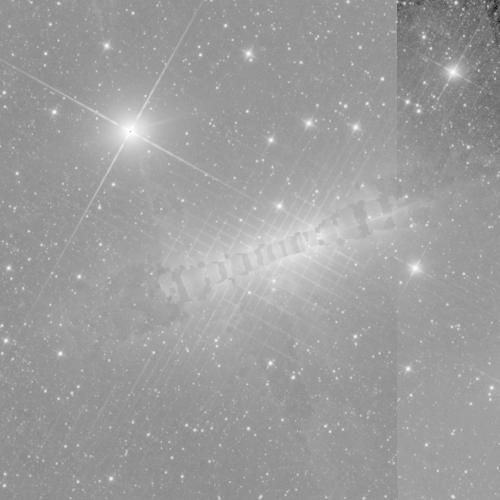Since there are more than 100 surveys in SkyView, it shouldn’t be surprising that we are not experts in the characteristics of each one. A blog reader noted that there is a very unusual feature in the WISE data near around 8 55 39, 19 36 44 and asked what it was. Off hand I couldn’t say. Here’s a one degree image from the WISE 3.4 micron data from the Gallery — though I admit that I put it there.

- Unusual Feature is WISE 3.4 Survey (1 degree centered at 8 55 39, 19 36 44)
It’s really quite an extraordinary object — but what is it, where does this grid pattern come from? It may be helpful to show how we can try to track this down. [The vertical boundary towards the right of the image is a failure of the algorithm that tries to match the backgrounds of adjacent images. That often has problems when there are very bright objects in the field but otherwise has nothing to do with the anomaly.]
The first step is to try to see if it’s real, i.e., could it just be some kind of glitch. Fortunately WISE has four different bands, so we can look at each of those. And indeed each of those shows something similar overall though the details vary quite a bit. It suggests that there really was something there.
If there was a real object there, then the only way it could cause this kind of weirdness was if was so bright that it overwhelmed the optics and electronics of the detector. Our first step is to check the bright star catalog. We can do that in SkyView itself, or at the HEASARC (using the BSC5P catalog). There don’t seem to be any objects in the field so the anomaly isn’t something like Sirius. By the bye that indicates that the apparently very bright star we see in the top left of the image is actually fainter than about 7th magnitude or so.
If it’s a bright natural object we’re running out options but we still have moving objects: planets, asteroids and such. The elongation of the object suggests a moving object. Only a few planets are likely to be bright enough though. If it is a planet then it should be close to the ecliptic plane. We convert the RA,Dec input to ecliptic coordinates (You can use the coordinate converter at the HEASARC for example.. We find that the ecliptic latitude is only about 2 degrees, very reasonable for a planet. Now we need to go to find detailed ephemerides for the bright planets. Let’s try the Horizons service at JPL. Infrared satellites don’t look close to the Sun usually, so we’ll skip Mercury and Venus. We really only need to look at Mars, Jupiter and Saturn.
The survey metadata indicate that the WISE data were taken in 2010, so we generate an ephemeris for Mars for that year. With a bit of luck we find a hit immediately. On April 27, 2010, Mars was at exactly the location we see the anomaly. At that time is was about apparent magnitude 0.5, so it was likely a thousand or more times brighter than the bright star we see in the image. That star is already showing very serious diffraction spikes, so its not surprising that something vastly brighter causes real problems.
Where does the grid come from? It seems like the WISE data is a sum of many images taken in quick succession. We get diffraction spikes on each one. As Mars moves the spikes form the pattern we see. Or maybe it’s something else entirely. With such a bright object very weird things may be happening in the electronics. But at least we know what we’re seeing.

I must admit, the title both made me chuckle and be curious. My wife is studying to be an astrophysicist and shares some amazing things with me. I’m intrigued and would love to hear the result of these findings.